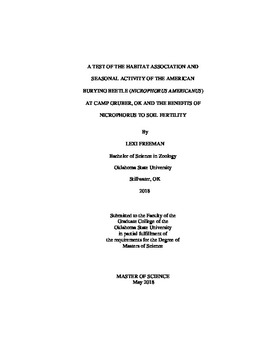| dc.contributor.advisor | Hoback, William Wyatt | |
| dc.contributor.author | Freeman, Lexi | |
| dc.date.accessioned | 2019-03-25T21:41:19Z | |
| dc.date.available | 2019-03-25T21:41:19Z | |
| dc.date.issued | 2018-05-01 | |
| dc.identifier.uri | https://hdl.handle.net/11244/317765 | |
| dc.description.abstract | Within the past decade, the American burying beetle, Nicrophorus americanus (ABB) have disappeared from approximately 90% of its former range. Efforts have been made to protect existing populations in the wild; however, ABB is considered a habitat generalist, which makes prioritizing conservation areas difficult. I sampled three habitat types: savannah, grassland, and forested areas. To compare across seasons, ABB were sampled from July 16, 2016 to November 12, 2017. I trapped a total of 1,756 unique individual ABB along with 10,448 individuals of 9 other Silphidae species. During the surveying period I found no significant difference in the habitat association of ABB. Overall trapping, forests had 6.0 ± 0.8, grasslands had 8.1 ± 1.2, and savannah had 8.2 ± 1.3 ABB per trap night. This suggests that across their active season, ABB are associated with all habitats at Camp Gruber. My data support the conclusion that ABB is a habitat generalist and is moving among the patches of different habitat types at Camp Gruber. | |
| dc.description.abstract | In order to determine influence of Eastern redcedar and brood success on soil fertility, I conducted a laboratory experiment with Nicrophorus marginatus and various soil mixtures. Test containers consisted of: soil/rat/beetles (14) and soil/cedar/rat/beetles (14). Control containers consisted of the following combinations: soil only (3), soil/cedar (3), soil/rat (4) and soil/cedar/rat (4). Burial success and adult survival were recorded. Live weight and dried weight were taken for each larva produce from successful brood balls and the soil mixtures were analyzed. Cedar needles did not have a significant difference to the soil nutrients in each treatment type. Experimental containers with larva had significantly higher average soluble salt content when compared to all other treatments (df = 3; p < 0.001). There was significantly higher nitrate level in the containers with beetles and rats, especially those with larval broods (df = 3; p < 0.05). Experimental containers with successful broods had significantly higher levels of phosphorus compared to soil-only treatments (df = 3; p < 0.05) and potassium was significantly higher in treatments containing beetles (df = 3; p < 0.05). It appears that Nicrophorus species may improve soil fertility while rearing broods. | |
| dc.format | application/pdf | |
| dc.language | en_US | |
| dc.rights | Copyright is held by the author who has granted the Oklahoma State University Library the non-exclusive right to share this material in its institutional repository. Contact Digital Library Services at lib-dls@okstate.edu or 405-744-9161 for the permission policy on the use, reproduction or distribution of this material. | |
| dc.title | Test of the Habitat Association and Seasonal Activity of the American Burying Beetle (Nicrophorus americanus) at Camp Gruber, OK, and the Benefits of Nicrophorus to Soil Fertility | |
| dc.contributor.committeeMember | Stoodley, Scott H. | |
| dc.contributor.committeeMember | Luttbeg, Barney | |
| osu.filename | Freeman_okstate_0664M_15647.pdf | |
| osu.accesstype | Open Access | |
| dc.description.department | Environmental Science | |
| dc.type.genre | Thesis | |
| dc.type.material | text | |
